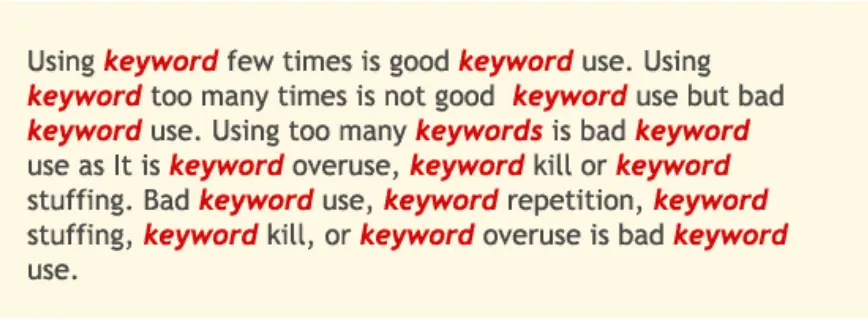Have you got keywords? If you have too many, you might be keyword-stuffing. What is keyword stuffing? In search engine optimization (SEO), keyword stuffing is when you repeatedly use the same keyword or phrase, affecting the content’s readability and usability.
If some keywords are good, then more must be better. That’s the simple logic behind keyword stuffing as a ranking factor.
Learn more about keyword stuffing in SEO now!

What is Keyword Stuffing?
“Keyword stuffing refers to the practice of filling a web page with keywords or numbers in an attempt to manipulate rankings in Google Search results. Often, these keywords appear in a list or group, unnaturally or out of content. We detect policy-violating content and behaviors both through automated systems and, as needed, human review that can result in a manual action. Sites that violate our policies may rank lower or not appear in results at all.”
Keyword stuffing is a type of spam where a website owner tries to disproportionately insert a wide range of keywords onto a web page in a bid to enhance their search rankings. Though it was an effective way of ranking higher in SERPs (search engine result pages) nowadays, it is a spam tactic, and search engines can penalize you for using it. To expand your knowledge about keywords in SEO, read our blog on What are Keywords in SEO?
Keyword stuffing can be done in several ways. On a visible page, it often results in content that doesn’t read well and an excessively high keyword density. It can also be hidden in meta keywords, which conceal additional keywords on a page. Understanding these methods can help avoid keyword stuffing and maintain ethical SEO practices.
Upskill Yourself With Live Training (Book Free Class)
| Suggested Courses for You | Book Live Class for FREE! |
| Digital Marketing Course | Book Now |
| SEO Course | Book Now |
| Google Ads Course | Book Now |
Examples of Keyword Stuffing in SEO
Consider a keyword stuffing example below:

The above example has various issues:
1. Keyword Density
The word “keyword” is used multiple times in a paragraph, which is highly unacceptable. This will induce penalties from search engines like Google.
2. Audience Targeting
The paragraph isn’t written conversationally for users to read and is meant to trick Google’s crawlers. A person visiting this paragraph will quickly turn off and leave the website.
3. Purpose of Content
There’s no sense of organization or cohesion in the paragraph. It’s just a place to use the keyword “keyword.”
Keyword stuffing may also occur in the following places:
a) Meta description and Title tag

b) URLs

c) Alt text

Though it’s normal for keywords to occur and reoccur within content, however, it’s unhelpful to insert them unnaturally or excessively.
Also Read: What Are LSI Keywords in SEO? Examples, Benefits, Use
Types of Keyword Stuffing
Let’s expand on keyword stuffing’s definition by exploring the 2 types of keyword stuffing:
1. Visible
Visible keyword stuffing is when the stuffing is visible to users. For example,
“Expedite your mornings with aluminum tea pods. With these aluminum tea pods, preparing tea becomes fast and easy. Purchase your aluminum tea pods today and bring more sunshine to your mornings!”
In the example above, we are keyword stuffing with aluminum tea pods.
2. Invisible/Hidden
Hidden keyword stuffing is when the stuffing is invisible to users. People hide keywords by:
- Matching text and background colors
- Placing text behind images
- Positioning text off-screen
- Using small, unreadable font sizes
With this black-hat SEO tactic, users don’t see the keywords, but search engines do. Previously, this tactic was effective for ranking in organic search results, but search engines have become skilled at detecting this spammy practice. Enrol in an online SEO course and learn to create a comprehensive SEO strategy.
Also Read: How to Do Keyword Research for SEO? 2025 Strategy
The Risks of Keyword Stuffing
Keyword spam hurts the user experience and is punishable by search engines since it is identified as poor-quality content. This is contrary to Google’s guidelines, and over the years, Google has launched various updates to limit the impact of SEO keyword stuffing.
1. Launch of Panda (2011)
The first algorithm update aims to penalize this kind of practice on sites. If Panda detects keyword stuffing on a web page, Google no longer displays the website on its concerned results.
2. Launch of Hummingbird (2013)
It allows natural language to consider a set of words as a whole and no longer independently of each other. This update values natural content instead of keyword-packed continents in the results.
3. Bert (2019)
This update considers the transition of words and nuances in the results.
4. Google’s Vicinity Update (2021)
This update lowered the weight of the establishment name in the listing’s ranking. Various listings that use keyword stuffing are dropped in results.
If you do keyword-stuffing on your website and Google detects it, then possible sanctions are:
- A warning email
- Partial Suspension (the listings remain visible on Google but cannot be edited)
- Hard Suspension (the listing disappears entirely from Google, and the reviews and photos are lost)
How does Keyword Stuffing Affect SEO?
A black hat SEO technique, keyword stuffing can severely affect a site’s SEO. Whenever a search engine crawls a website, it evaluates the content to decide the website’s relevance to a particular keyword or phrase. The search engine uses algorithms to know the keywords used on a website and how often they are used. If a website uses keywords absurdly, the search engine will consider its keyword stuffing, penalizing the website by decreasing its search engine rankings.
Keyword spamming can negatively affect a website’s SEO in numerous ways. Firstly, it decreases the website’s visibility on search engines. When a website is fined for keyword stuffing, it no longer appears on the first page of search engine results, making it much more difficult for users to find. Plus, keyword stuffing decreases the website’s credibility. When a site is penalized for keyword stuffing, visitors may perceive it as untrustworthy, and they will be less likely to visit it.
Another way keyword stuffing can badly affect SEO is by making the content of the website unreadable and irrelevant. Whenever a website uses keywords excessively, the content is difficult to understand and appears less relevant to the user. This results in substantial bounce rates and low engagement, indicating to search engines that the website doesn’t offer valuable content to its users.
It’s crucial for website owners and marketers to recognize that keyword stuffing is an ineffective strategy for improving a website’s SEO. Instead, they should focus on generating high-quality, relevant, and engaging content that naturally incorporates keywords. Website owners should also leverage other SEO methods like link building and meta tags to enhance their search engine rankings.
To avoid keyword stuffing, website owners must limit the use of keywords to 2-3% of the entire content. That means for every 100 words of content, keywords should only be used 2-3 times. Website owners should use synonyms and variations of keywords to make the content more relevant.
Why Keyword Stuffing is Bad?
Keyword stuffing is bad for SEO because it leads to poor-quality content. Unnatural use of keywords looks spammy and discourages visitors from interacting with your page or link, thereby harming your brand’s image. Moreover, if you purposefully stuff a webpage with keywords, it’s unlikely to rank well.
Further, keyword stuffing violates Google’s spam policies. Suppose Google detects that you have stuffed keywords into on-site content or built various types of backlinks that use overly keyword-rich anchor text across several domains. In that case, your ranking will surely suffer or even receive a Google penalty. This means your website will be removed from the Google search engine. Although keyword stuffing is unethical, a few webmasters succeed with black-hat SEO methods. Search engines like Google update their algorithms yearly to diminish the returns of these strategies.
Visible keyword stuffing affects user experience, and no one enjoys reading repetitive content, which is what keyword spamming creates. In response, readers might bounce from your site and avoid your content in the search results later.
Interview Questions for You to Prepare for Jobs
| Digital Marketing Interview Questions | SEO Interview Questions |
| Content Writing Interview Questions | Content Writing Interview Questions |
Why Websites Use Keyword Stuffing?
Websites use keyword stuffing in a misguided attempt to earn higher SEO rankings. Earlier, keyword stuffing used to lead to higher rankings, and Google’s algorithm treated pages with keywords or more repetitions of the keyword as relevant, giving weightage to keyword-rich backlinks. To know more about backlinks, read our blog on What are Backlinks in SEO?
Later, Google rolled out various algorithm updates to devaluate or penalize keyword stuffing. This means Google understands context and ranks pieces depending on factors such as comprehensiveness and search intent instead of how many times you use a keyword. Further, Google’s current web spam detection systems are more effective and will harm your performance in search results. Master SEO skills by joining SEO courses with expert-led sessions from industry professionals.
Also Read: Do follow vs. No follow Backlinks (Difference & Comparision)
How to Identify Keyword Stuffing?
To verify keyword stuffing, analyze your web pages to measure the percentage of keywords in the content and compare it to the recommended 1-3% range.
Next, use keyword research tools to check the keywords difficulty and competition of your target keywords. Plagiarism tools assist in detecting any duplicate or copied content that may contain keyword spamming. Plus, read your content to decide if it sounds engaging, natural, and informative.
How to Avoid Keyword Stuffing?
Typically, web page owners opt for keyword stuffing as a quick fix for optimization. However, this quick fix will hurt you more in the long run.
A few ways to avoid keyword stuffing are:
1. Quality and Thorough Keyword Research is a Must
Studying the core market, determining what is widespread, and analyzing keyword difficulty are significant components of good keyword research. Learning keyword popularity is crucial as it indicates how often a keyword is searched for.
Further, assessing keyword difficulty is also necessary. The higher this metric is, the harder it is to rank on the first SERP. While analyzing keyword difficulty, the below measurements are key:
- Domain Authority
- Page Authority
- Website’s trustworthiness
2. Increased Word Count
Expanding the body of your text helps you distribute keywords more naturally instead of forcing them into every other sentence. This will improve the text’s flow and user experience.
3. Measure Your Keyword Density
The ideal keyword density must be below 2%. Keyword Density Checker tools help you ensure you stay below this percentage and keep your content sounding natural.
4. Set Primary Keyword for Every Page
Look for a target keyword for each web page, which must be closely related to its content. Choose a low-competition keyword to rank quickly. However, remember to pick up a different primary keyword for every page on your website.
5. Usage of Keywords for On-page SEO
Insert keywords in the appropriate sections of your page, including:
- Title tag
- Meat description
- Image alt tag
- First paragraph
- Page title

FAQs on Keyword Stuffing in SEO
While there isn’t a defined number of keyword mentions that would flag your content as keyword stuffing, it’s essential to use your keyword in moderation. Read through your content to ensure it sounds natural, and try to use secondary keywords to prevent the appearance of keyword stuffing.
Keyword stuffing violates Spam policies for Google web search, and can lead to the webpage or site getting penalized. While Google may impose a manual action, most keyword stuffing is handled algorithmically. If the algorithm detects keyword stuffing, it’ll either downgrade the page in rankings or not list it.
Search engines no longer rely on term frequency to understand webpage content. Instead, they use advanced information analysis and retrieval systems that prioritize the quality of your content over how many times you repeat your keyword. Keyword stuffing can harm your ranking, making it a spam factor rather than a ranking factor.
Conclusion
Keyword stuffing is a dead strategy, not because Google informed webmasters to stop doing it, but because it genuinely lowers your overall user experience. You lose audience loyalty, ranks, and potential all at once, so don’t cheat the system by keyword spamming smartly. Instead, focus on writing natural, informative, detailed content and focus on end-user needs instead of the exact phrasing they use in searches.
Read more blogs:



